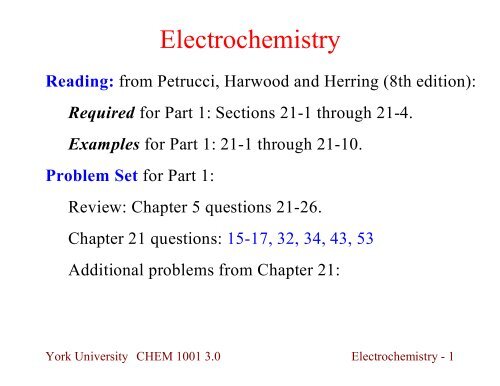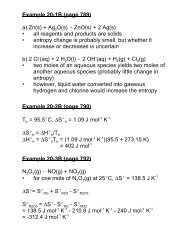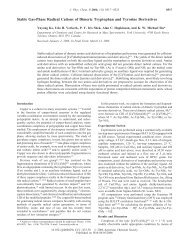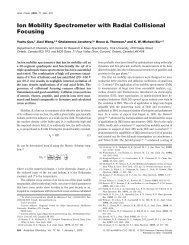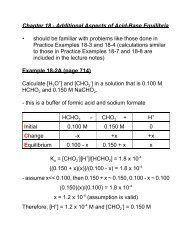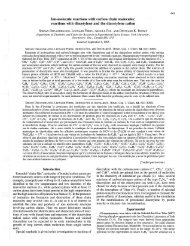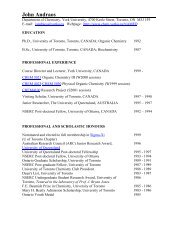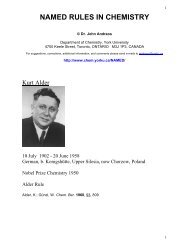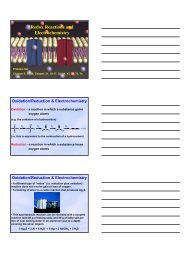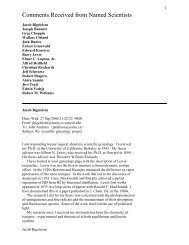Electrochemistry
Electrochemistry
Electrochemistry
You also want an ePaper? Increase the reach of your titles
YUMPU automatically turns print PDFs into web optimized ePapers that Google loves.
<strong>Electrochemistry</strong><br />
Reading: from Petrucci, Harwood and Herring (8th edition):<br />
Required for Part 1: Sections 21-1 through 21-4.<br />
Examples for Part 1: 21-1 through 21-10.<br />
Problem Set for Part 1:<br />
Review: Chapter 5 questions 21-26.<br />
Chapter 21 questions: 15-17, 32, 34, 43, 53<br />
Additional problems from Chapter 21:<br />
York University CHEM 1001 3.0 <strong>Electrochemistry</strong> - 1
Applications of <strong>Electrochemistry</strong><br />
Spontaneous chemical reactions can be used to produce<br />
an electric current and do work. (batteries, fuel-cells)<br />
An electric current can be used to force non-spontaneous<br />
chemical reactions to occur. (electrolysis)<br />
Reactions can be made to occur in a specific place.<br />
(electroplating, electropolishing)<br />
The voltage produced by a reaction can be used as an<br />
analytical tool. (pH electrodes)<br />
The current produced by a reaction can be used as an<br />
analytical tool.<br />
York University CHEM 1001 3.0 <strong>Electrochemistry</strong> - 2
G and non-PV Work<br />
For a reversible process at constant T and P:<br />
H = q P + w E<br />
(definition of enthalpy)<br />
w E = non-PV work done on the system<br />
q P = TS (reversible, constant T)<br />
Let w max = maximum non-PV work done by the system<br />
w max = -w E<br />
(reversible)<br />
So<br />
w max = -H + TS = -G<br />
Conclusion: The maximum non-PV work that can be<br />
obtained from a process is equal to -G.<br />
York University CHEM 1001 3.0 <strong>Electrochemistry</strong> - 3
Work from Chemical Reactions<br />
Spontaneous chemical reactions can be used to do work.<br />
How?<br />
One possibility:<br />
burn fuel to release heat<br />
boil water<br />
use the expanding steam to do work<br />
Disadvantages:<br />
inefficient (only part of heat can be turned into work)<br />
can not readily carry out the reverse process<br />
York University CHEM 1001 3.0 <strong>Electrochemistry</strong> - 4
Work from Redox Reactions<br />
Another method: Use redox reactions.<br />
Cu(s) + 2Ag + Cu 2+ + 2Ag(s) r G° = -88.43 kJ mol -1<br />
The Cu(s) is oxidized (gives up electrons).<br />
Half-reaction: Cu(s) Cu 2+ + 2e -<br />
The Ag + (aq) is reduced (receives electrons).<br />
Half-reaction: Ag + + e - 2Ag(s)<br />
This reaction is spontaneous. If we can transfer the electrons<br />
through an external circuit, we can use it do electrical work.<br />
York University CHEM 1001 3.0 <strong>Electrochemistry</strong> - 5
Cu is oxidized at<br />
one electrode:<br />
Cu(s) Cu 2+ + 2e -<br />
Ag + is reduced at<br />
the other electrode:<br />
e - + Ag + Ag(s)<br />
Electrons travel<br />
through the wire.<br />
Ions travel through<br />
the salt bridge.<br />
Electrochemical Cells<br />
York University CHEM 1001 3.0 <strong>Electrochemistry</strong> - 6
Atomic View of an Electrochemical Cell<br />
York University CHEM 1001 3.0 <strong>Electrochemistry</strong> - 7
Electrochemical Cells - Terminology<br />
The anode is the electrode at which oxidation occurs.<br />
The cathode is the electrode at which reduction occurs.<br />
The cell potential is the voltage difference when no<br />
current flows between the electrodes.<br />
Cell potential is also called cell voltage or EMF<br />
(electromotive force).<br />
Cells in which spontaneous reactions produce a current<br />
are called voltaic cells or galvanic cells.<br />
In electrolytic cells electricity is used to force a nonspontaneous<br />
reaction to occur.<br />
York University CHEM 1001 3.0 <strong>Electrochemistry</strong> - 8
Cell Diagrams<br />
Anode (oxidation) is placed on left side of diagram.<br />
Cathode (reduction) is placed on right side of diagram.<br />
Single vertical line, | , indicates a boundary between<br />
different phases (i.e., solution | solid).<br />
Double vertical line, || , indicates a boundary (salt bridge)<br />
between different half-cell compartments.<br />
Example: Cu(s) Cu 2+ Ag + Ag(s)<br />
At the anode: Cu(s) Cu 2+ + 2e -<br />
At the cathode:<br />
Overall:<br />
Ag + + e - Ag(s)<br />
Cu(s) + 2Ag + Cu 2+ + 2Ag(s)<br />
York University CHEM 1001 3.0 <strong>Electrochemistry</strong> - 9
Cell Diagrams - examples<br />
Diagram the cell in which the following overall reaction<br />
occurs:<br />
Pb(s) + 2AgCl(s) PbCl 2 (s) + 2Ag(s)<br />
Answer: Pb(s)Cl - (aq)PbCl 2 (s))AgCl(s)Ag(s)Cl - (aq)<br />
Write the half-cell reactions for the following cell:<br />
Ag(s)Ag + (aq)Cl - (aq)AgCl(s)Ag(s)<br />
Answer:<br />
Anode (oxidation): Ag(s) Ag + (aq) + e -<br />
Cathode (reduction): AgCl(s) + e - Ag(s) + Cl - (aq)<br />
York University CHEM 1001 3.0 <strong>Electrochemistry</strong> - 10
Balancing Redox Reactions - Review<br />
Example: SO 3 2- + MnO 4- SO 4 2- + Mn 2+ (unbalanced)<br />
S from +4 to +6 (oxidized). Mn from +7 to +2 (reduced).<br />
(1) Write balanced half-reactions for oxidation and<br />
reduction.<br />
Oxidation half-reaction<br />
Skeleton reaction: SO 3<br />
2-<br />
SO 4 2- + 2e -<br />
Balanced: SO 3 2- + H 2 O(l) SO 4 2- + 2H + + 2e -<br />
Reduction half-reaction<br />
Skeleton reaction: MnO 4 - + 5e - Mn 2+<br />
Balanced:<br />
MnO 4 - + 8H + + 5e - Mn 2+ + 4H 2 O(l)<br />
York University CHEM 1001 3.0 <strong>Electrochemistry</strong> - 11
Balancing Redox Reactions - continued<br />
(2) Adjust coefficients so the two half-reactions have the<br />
same numbers of electrons.<br />
5SO 3 2- + 5H 2 O(l) 5SO 4 2- + 10H + + 10e -<br />
2MnO 4 - + 16H + + 10e - 2Mn 2+ + 8H 2 O(l)<br />
(3) Add the two half-reactions.<br />
5SO 3 2- + 2MnO 4 - + 6H + 5SO 4 2- + 2Mn 2+ + 3H 2 O(l)<br />
10 electrons are transferred (important for later).<br />
(4) Check that the reaction is balanced for both atoms and<br />
charge.<br />
York University CHEM 1001 3.0 <strong>Electrochemistry</strong> - 12
Redox Reactions in Basic Solution<br />
5SO 3 2- + 2MnO 4 - + 6H + 5SO 4 2- + 2Mn 2+ + 3H 2 O(l)<br />
Since this balanced reaction involves H + , it is appropriate<br />
for acidic solution<br />
For the reaction in basic solution, add<br />
This gives:<br />
6 × {H 2 O(l) H + + OH - }<br />
5SO 3 2- + 2MnO 4 - + 3H 2 O(l) 5SO 4 2- + 2Mn 2+ + 6OH -<br />
This method can also be used to get half-reactions in basic<br />
solution.<br />
York University CHEM 1001 3.0 <strong>Electrochemistry</strong> - 13
Current and Charge<br />
Current is the amount of charge transferred per unit time.<br />
The amount of charge transferred is determined by the<br />
stoichiometry of the cell reaction.<br />
The charge on one mole of electrons is 96,485 coulombs.<br />
This is called the Faraday constant, F.<br />
F = 96,485 C mol -1 = 96,485 J V -1 mol -1<br />
Example: Cu(s) + 2Ag + Cu 2+ + 2Ag(s)<br />
1.93×10 5 C are transferred per mole of Cu oxidized.<br />
The current produced by a cell is determined by the reaction<br />
kinetics and the resistance of the circuit.<br />
York University CHEM 1001 3.0 <strong>Electrochemistry</strong> - 14
Electrical Work<br />
The work done in an electrical circuit is<br />
Units:<br />
w elec = charge × (potential difference)<br />
coulombs × volts = joules<br />
The maximum possible non-PV work equals -G. Let<br />
n moles of electrons transferred per mole of reaction<br />
nF = total charge (coulombs) transferred<br />
E cell maximum possible cell potential (requires zero<br />
current)<br />
Then:<br />
r G = -nFE cell<br />
York University CHEM 1001 3.0 <strong>Electrochemistry</strong> - 15
Electrical Work - continued<br />
r G = -nFE cell<br />
There is a fundamental connection between r G and cell<br />
potential. Because of this:<br />
Cell potentials depend on concentrations.<br />
Electrochemical cells can be used to measure<br />
concentrations. (pH electrodes, for example)<br />
Electrochemical cells can be used to measure r G (and<br />
to determine r G°).<br />
Tabulated thermodynamic data can be used to determine<br />
cell potentials.<br />
York University CHEM 1001 3.0 <strong>Electrochemistry</strong> - 16
Cell Potential - Example<br />
A cell is constructed in which the half-cell reactions are:<br />
Anode: H 2 (g) 2H + (aq) + 2e -<br />
Cathode:<br />
Cl 2 (g) + 2e - 2Cl - (aq)<br />
When P H2 = P Cl2 = 1.000 atm and [H + ] = [Cl - ] = 0.0100 M,<br />
the cell potential is found to be 1.4813 volts. Find r G<br />
under these conditions for<br />
H 2 (g) + Cl 2 (g) 2H + (aq) + 2Cl - (aq)<br />
Solution: r G = -nFE cell and n = 2 for the overall reaction.<br />
r G = -2(96,485 J V -1 mol -1 )(1.4813 V) = -285.85 kJ mol -1<br />
York University CHEM 1001 3.0 <strong>Electrochemistry</strong> - 17
Cell Potentials and Spontaneity<br />
r G = -nFE cell<br />
If r G < 0, the reaction is spontaneous as written.<br />
If r G > 0, the reaction is non-spontaneous as written<br />
(reverse reaction is spontaneous).<br />
If the reaction proceeds as written, then n > 0.<br />
Therefore:<br />
If E cell > 0, the reaction is spontaneous as written.<br />
If E cell < 0, the reaction is non-spontaneous as written.<br />
York University CHEM 1001 3.0 <strong>Electrochemistry</strong> - 18
Standard Cell Potentials<br />
Definition: The standard cell potential, E° cell , is the cell<br />
potential that would obtain if all reactants and products were<br />
in their standard states.<br />
Therefore:<br />
r G° = -nFE° cell<br />
Standard states may be hypothetical. The standard cell<br />
potential is used in calculations of actual cell potentials.<br />
The standard cell potential is the sum of standard potentials<br />
for the individual half-cells.<br />
York University CHEM 1001 3.0 <strong>Electrochemistry</strong> - 19
Standard Cell Potential - example<br />
The cell with the overall reaction<br />
H 2 (g) + Cl 2 (g) 2H + (aq) + 2Cl - (aq)<br />
has a standard cell potential of 1.3604 V. Determine f G°<br />
for Cl - (aq).<br />
Solution:<br />
r G° = -nFE° cell<br />
r G° = -2(96,485 C mol -1 )(1.3604 V) = -262.52 kJ mol -1<br />
For H 2 (g), Cl 2 (g), and H + (aq); f G° = 0.<br />
r G° = 2 f G°(Cl - (aq))<br />
f G°(Cl - (aq)) = -131.26 kJ mol -1<br />
York University CHEM 1001 3.0 <strong>Electrochemistry</strong> - 20
Standard Hydrogen Electrode<br />
To create a voltage, we need two half-cells. So we<br />
can't measure individual half-cell potentials.<br />
Convention: The standard hydrogen electrode is<br />
assigned a half-cell potential of zero.<br />
2H + (aq) + 2e - H 2 (g) E° = 0 volts<br />
Standard states (a=1): [H + ] 1 M, P H2 = 1 bar 1 atm<br />
The half-cell potential will differ from zero if H + and/or<br />
H 2 are not in their standard states.<br />
York University CHEM 1001 3.0 <strong>Electrochemistry</strong> - 21
Standard Hydrogen Electrode - continued<br />
H 2 (g) at one bar<br />
bubbled over a<br />
platinum electrode.<br />
Pt acts a catalyst for<br />
the reaction.<br />
2H + + 2e - H 2 (g)<br />
Used as a basis for<br />
calculations. Not<br />
really very practical.<br />
York University CHEM 1001 3.0 <strong>Electrochemistry</strong> - 22
Standard Electrode Potentials<br />
The standard electrode potential for a half-cell is the<br />
potential when all species are in their standard states.<br />
refers to reduction at the electrode (these days)<br />
measured relative to a standard hydrogen electrode as<br />
the anode<br />
Example: Cell for measuring E° for Cu 2+ /Cu.<br />
Anode: H 2 (g) 2H + + 2e - (oxidation)<br />
Cathode: Cu 2+ (1 M) + 2e - Cu(s) (reduction)<br />
Cell Diagram: PtH 2 (1 bar)H + (1 M)Cu 2+ (1 M)Cu(s)<br />
Cell potential is 0.340 V. So E° = 0.340 V for Cu 2+ /Cu.<br />
York University CHEM 1001 3.0 <strong>Electrochemistry</strong> - 23
Standard Electrode Potentials - continued<br />
Reduction Half-Reaction E° (volts)<br />
F 2 (g) + 2e - 2F - (aq) 2.866<br />
O 2 (g) + 4H + (aq) + 4e - 2H 2 O(l) 1.229<br />
2H + (aq) + 2e - H 2 (g) 0.000<br />
Zn 2+ (aq) + 2e - Zn(s) -0.763<br />
Li + (aq) + e - Li(s) -3.040<br />
F 2 is easiest to reduce (largest E°). F - is hardest to oxidize.<br />
Li + is hardest to reduce. Li is easiest to oxidize.<br />
F 2 is best oxidizing agent; Li is best reducing agent.<br />
York University CHEM 1001 3.0 <strong>Electrochemistry</strong> - 24
Using Standard Electrode Potentials<br />
A standard cell potential, E° cell , may be calculated from the<br />
standard electrode potentials for the cathode, E° cathode , and<br />
anode, E° anode :<br />
E° cell = E° cathode - E° anode<br />
The anode potential is subtracted since the potential is for<br />
reduction and the anode reaction is oxidation.<br />
Standard electrode potentials are listed in tables.<br />
Standard electrode potentials do not depend on how a<br />
reaction is written since they are related to r G° per mole<br />
of electrons. ( r G° = -nFE° cell )<br />
York University CHEM 1001 3.0 <strong>Electrochemistry</strong> - 25
Standard Electrode Potentials - example<br />
Find the standard cell potential for the reaction:<br />
Zn(s) + Cl 2 (g) Zn 2+ (aq) + 2Cl - (aq)<br />
Solution: Write half-cell reactions and find E° values.<br />
Oxidation: Zn(s) Zn 2+ (aq) + 2e -<br />
Reduction: Cl 2 (g) + 2e - 2Cl - (aq)<br />
From Table 21.1:<br />
Zn 2+ (aq) + 2e - Zn(s) E° = -0.763 V<br />
Cl 2 (g) + 2e - 2Cl - (aq) E° = 1.358 V<br />
E° cell = E° cathode - E° anode = 1.358 - (-0.763) = 2.121 V<br />
York University CHEM 1001 3.0 <strong>Electrochemistry</strong> - 26
Cell Potential and Equilibrium Constant<br />
We have derived the following two equations:<br />
r G° = -nFE° cell and r G° = -RTln K eq<br />
Combining these gives<br />
Uses of this equation:<br />
E° cell = lnK eq<br />
Calculating K eq from standard half-cell potentials (see<br />
example 21-7 in text).<br />
Relating E° cell for different reactions.<br />
York University CHEM 1001 3.0 <strong>Electrochemistry</strong> - 27
Cell Potential and Equilibrium - Example<br />
At 298.15 K, the standard reduction potential for O 2 (g) in<br />
acidic solution is 1.229 V:<br />
O 2 (g) + 4H + (aq) + 4e - 2H 2 O(l) E 1 ° = 1.229 V<br />
Find the standard reduction potential for O 2 (g) in basic<br />
solution:<br />
O 2 (g) + 2H 2 O(l) + 4e - 4OH - (aq) E 2 ° = ?<br />
Solution: The second reaction is equal to the first plus<br />
4H 2 O(l) 4H + (aq) + 4OH - (aq) K eq = K W<br />
4<br />
So K 2 = K 1 K W 4 , E 2 ° = (RT/nF)ln(K 1 K W 4 ), n = 4<br />
E 2 ° = E 1 ° + (RT/F)lnK W = 1.229 + 0.02569 ln(1.0×10 -14 )<br />
E 2 ° = 0.401 V<br />
York University CHEM 1001 3.0 <strong>Electrochemistry</strong> - 28
Dissolving Metals with Acids<br />
Many metals are dissolved by acids with the evolution<br />
of H 2 (g).<br />
Oxidation: M(s) M n+ (aq) + ne - E° = E° M<br />
Reduction: 2H + (aq) + 2e - H 2 (g) E° = 0<br />
Overall: M(s) + nH + (aq) M n+ (aq) + (n/2)H 2 (g) E° = -E° M<br />
Conclusions:<br />
The more negative the standard reduction potential of the<br />
metal ion, the easier the metal is to dissolve.<br />
Lowering the pH promotes the dissolution of metals.<br />
York University CHEM 1001 3.0 <strong>Electrochemistry</strong> - 29
Dissolving Metals with Acids - example<br />
Determine the concentrations of each of the following<br />
metals that will dissolve at pH = 7.00 and pH = 0.00.<br />
Cu 2+ (aq) + 2e - Cu(s)<br />
Pb 2+ (aq) + 2e - Pb(s)<br />
Zn 2+ (aq) + 2e - Zn(s)<br />
Solution: M(s) + 2H + (aq) M 2+ (aq) + H 2 (g)<br />
E° = 0.340 V<br />
E° = -0.125 V<br />
E° = -0.763 V<br />
n = 2 E° cell = -E° T = 298.15 K P H2 1 bar<br />
E° cell = (RT/nF)lnK eq K eq = exp(-(77.85 V -1 )E°)<br />
[M 2+ ] [H + ] 2 K eq = [H + ] 2 exp(-(77.85 V -1 )E°)<br />
York University CHEM 1001 3.0 <strong>Electrochemistry</strong> - 30
Dissolving Metals with Acids - continued<br />
[M 2+ ] [H + ] 2 exp(-(77.85 V -1 )E°)<br />
pH = 7 pH = 0 E° (V)<br />
[Cu 2+ ] eq = 3.2×10 -26 M 3.2×10 -12 M 0.340<br />
[Pb 2+ ] eq = 1.7×10 -10 M 1.7×10 4 M -0.125<br />
[Zn 2+ ] eq = 6.3×10 11 M 6.3×10 25 M -0.763<br />
Metals with E° 0 are difficult to dissolve even in<br />
strong acids.<br />
Metals with E° 0 will dissolve in strong acids.<br />
Metals with E° 0 will dissolve in water.<br />
York University CHEM 1001 3.0 <strong>Electrochemistry</strong> - 31
Enhancing Dissolution of Metals<br />
Concentrated HNO 3 will dissolve Cu(s):<br />
Cu 2+ (aq) + 2e - Cu(s)<br />
NO 3 - + 4H + + 4e - NO(g) + H 2 O(l)<br />
E° = 0.340 V<br />
E° = 0.956 V<br />
For the overall reaction, E° = (0.956 - 0.340) V = 0.616 V.<br />
This is very favorable.<br />
Gold can be dissolved using aqua regia (1 part HNO 3 to<br />
3 parts HCl):<br />
Au 3+ (aq) + 3e - Au(s)<br />
E° = 1.52 V<br />
Au 3+ (aq) + 4Cl - (aq) [AuCl 4 ] - (aq)<br />
York University CHEM 1001 3.0 <strong>Electrochemistry</strong> - 32
We have shown that<br />
The Nernst Equation<br />
r G = -nFE cell<br />
But r G depends on the concentrations of reactants and<br />
products:<br />
r G = r G° + RTlnQ<br />
Therefore, E cell also depends on concentrations. Combining<br />
these gives nFE cell = nFE° cell - RTlnQ. So<br />
This is known as the Nernst Equation.<br />
York University CHEM 1001 3.0 <strong>Electrochemistry</strong> - 33
The Nernst Equation - continued<br />
Here: R = 8.314 J mol -1 K -1<br />
F = 96,485 C mol -1 = 96,485 J V -1 mol -1<br />
lnQ = ln(10)×logQ = 2.303 logQ<br />
So<br />
E cell = E° cell - (1.984×10 -4 V K -1 )(T/n)logQ<br />
If T = 298.15 K (25 °C), then<br />
E cell = E° cell - (1/n)(0.05916 V)logQ<br />
York University CHEM 1001 3.0 <strong>Electrochemistry</strong> - 34
Using the Nernst Equation<br />
Find E cell at 298 K for the cell<br />
PtFe 2+ (0.10 M),Fe 3+ (0.20 M)Ag + (1.0 M)Ag(s)<br />
Solution: First find E° cell , then use the Nernst Equation.<br />
Anode: Fe 2+ Fe 3+ + e - E° = 0.771 V<br />
Cathode: Ag + + e - Ag(s) E° = 0.800 V<br />
Cell: Fe 2+ + Ag + Fe 3+ + Ag(s)<br />
E° cell = E° cathode - E° anode = 0.029 V n = 1<br />
Q = [Fe 3+ ] / [Fe 2+ ][Ag + ] = (0.20) / (0.10)(1.0) = 2.0<br />
E cell = E° cell - (1/n)(0.05916 V)logQ = 0.011 V<br />
York University CHEM 1001 3.0 <strong>Electrochemistry</strong> - 35
We can make a cell<br />
with the same<br />
reaction occuring at<br />
both electrodes.<br />
E° cell = 0<br />
The cell voltage is<br />
due to the difference<br />
in concentration.<br />
Concentration Cells<br />
York University CHEM 1001 3.0 <strong>Electrochemistry</strong> - 36
Determining K sp<br />
With saturated AgI(aq) at the anode and [Ag + ] = 0.100 M at<br />
the cathode, E cell = 0.417 V. Use this to find K sp .<br />
Anode: Ag(s) Ag + (aq, sat. AgI) + e -<br />
Cathode:<br />
Cell:<br />
Ag + (aq, 0.1M) + e - Ag(s)<br />
Ag + (aq, 0.1M) Ag + (aq, sat. AgI)<br />
E° cell = 0. Q = [Ag + ] sat,KI / [0.1 M]. n = 1.<br />
The Nernst equation becomes (at 298.15 K):<br />
0.417 V = E cell = - (0.05916 V) log([Ag + ] sat,KI / [0.1 M])<br />
[Ag + ] sat,KI = [0.1 M] 10 -7.049 = 8.94×10 -9 M<br />
K sp = [I - ][Ag + ] = (8.94×10 -9 ) 2 = 7.99×10 -17<br />
York University CHEM 1001 3.0 <strong>Electrochemistry</strong> - 37
<strong>Electrochemistry</strong> Basics - Summary<br />
Electrochemical cells permit us to couple electrical<br />
work to chemical reactions.<br />
Cell potential and r G are directly related:<br />
r G = -nFE cell .<br />
Standard reduction potentials are tabulated and may<br />
be used to compute E° cell and r G°.<br />
The effect of concentration on cell potential is given<br />
by the Nernst equation:<br />
York University CHEM 1001 3.0 <strong>Electrochemistry</strong> - 38


